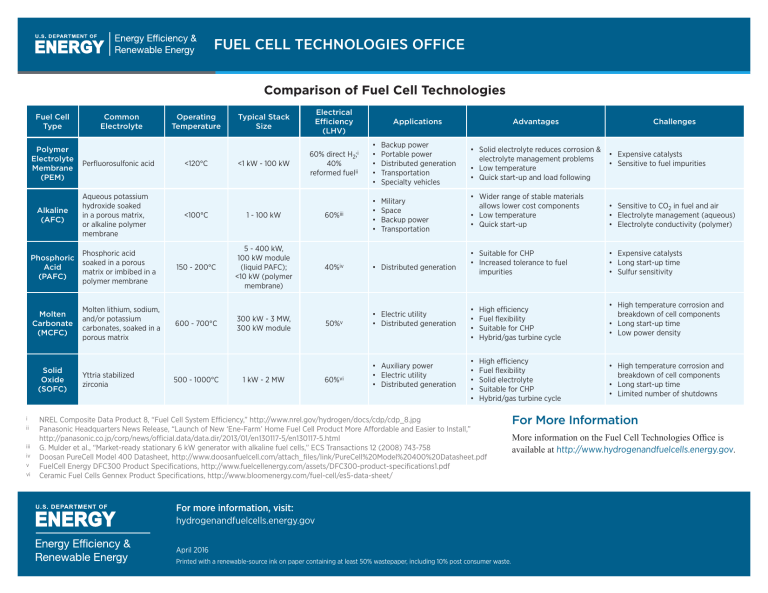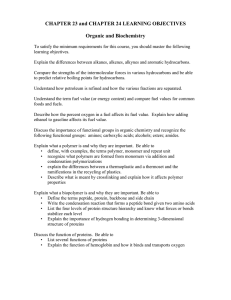
FUEL CELL TECHNOLOGIES OFFICE Comparison of Fuel Cell Technologies Fuel Cell Type Polymer Electrolyte Membrane (PEM) Alkaline (AFC) ii iii iv v vi Perfluorosulfonic acid Aqueous potassium hydroxide soaked in a porous matrix, or alkaline polymer membrane Phosphoric Acid (PAFC) Phosphoric acid soaked in a porous matrix or imbibed in a polymer membrane Molten Carbonate (MCFC) Molten lithium, sodium, and/or potassium carbonates, soaked in a porous matrix Solid Oxide (SOFC) i Common Electrolyte Yttria stabilized zirconia Operating Temperature <120°C Typical Stack Size Electrical Efficiency (LHV) <1 kW - 100 kW 60% direct H2;i 40% reformed fuelii Applications Advantages • • • • • Backup power Portable power Distributed generation Transportation Specialty vehicles • Solid electrolyte reduces corrosion & electrolyte management problems • Low temperature • Quick start-up and load following Military Space Backup power Transportation <100°C 1 - 100 kW 60%iii • • • • 150 - 200°C 5 - 400 kW, 100 kW module (liquid PAFC); <10 kW (polymer membrane) 40%iv • Distributed generation 600 - 700°C 300 kW - 3 MW, 300 kW module 50%v • Electric utility • Distributed generation 500 - 1000°C 1 kW - 2 MW 60%vi • Auxiliary power • Electric utility • Distributed generation Challenges • Expensive catalysts • Sensitive to fuel impurities • Wider range of stable materials allows lower cost components • Low temperature • Quick start-up • Sensitive to CO2 in fuel and air • Electrolyte management (aqueous) • Electrolyte conductivity (polymer) • Suitable for CHP • Increased tolerance to fuel impurities • Expensive catalysts • Long start-up time • Sulfur sensitivity • • • • High efficiency Fuel flexibility Suitable for CHP Hybrid/gas turbine cycle • • • • • High efficiency Fuel flexibility Solid electrolyte Suitable for CHP Hybrid/gas turbine cycle NREL Composite Data Product 8, “Fuel Cell System Efficiency,” http://www.nrel.gov/hydrogen/docs/cdp/cdp_8.jpg Panasonic Headquarters News Release, “Launch of New ‘Ene-Farm’ Home Fuel Cell Product More Affordable and Easier to Install,” http://panasonic.co.jp/corp/news/official.data/data.dir/2013/01/en130117-5/en130117-5.html G. Mulder et al., “Market-ready stationary 6 kW generator with alkaline fuel cells,” ECS Transactions 12 (2008) 743-758 Doosan PureCell Model 400 Datasheet, http://www.doosanfuelcell.com/attach_files/link/PureCell%20Model%20400%20Datasheet.pdf FuelCell Energy DFC300 Product Specifications, http://www.fuelcellenergy.com/assets/DFC300-product-specifications1.pdf Ceramic Fuel Cells Gennex Product Specifications, http://www.bloomenergy.com/fuel-cell/es5-data-sheet/ For more information, visit: hydrogenandfuelcells.energy.gov April 2016 Printed with a renewable-source ink on paper containing at least 50% wastepaper, including 10% post consumer waste. • High temperature corrosion and breakdown of cell components • Long start-up time • Low power density • High temperature corrosion and breakdown of cell components • Long start-up time • Limited number of shutdowns For More Information More information on the Fuel Cell Technologies Office is available at http://www.hydrogenandfuelcells.energy.gov.

